|
Michael McFadyen's Scuba Diving - HMNZS Canterbury
In August 1968 the New Zealand Government placed an order for a second Leander Class frigate. The first, HMNZS Waikato had been ordered in June 1963 and it had been laid down on 16 September 1963. She was commissioned on 19 September 1966. The Leander Class were a United Kingdom design developed from the earlier Rothesay and Whitby classes. The Leander Class was almost the same as the Australian River Class (eg HMAS Swan now a dive site off Dunsborough, Western Australia).
On 12 April 1969 the hull of the new destroyer was laid down in the Yarrow and Company Limited shipyard at Scotstoun, Glasgow, Scotland. The ship was launched on 6 May 1970 and named HMNZS Canterbury. The new ship was 113.4 metres long (109.7 metres waterline) and 13.1 metres wide. It had a tonnage of approximately 2,500 tonnes. The ship was powered by two English Electric shaft geared steam turbines (30,000 shp) giving a top speed of 28 knots. Steam came from two Babcock and Wilcox boilers. It had a range of 8,520 kilometres at 15 knots.
Armament for the new ship was two Vickers 4.5" (114mm) L45 DP guns in one Mk 6 twin mounting in front of the bridge, a Sea Cat missile system (removed early 1990s and replaced by Phalanx CIWS), four 12.7 mm AA guns and Mod 5 Mark 46 torpedoes in Mark 32 torpedo tubes. Defensive equipment included two Mark 36 SRBOC Mod 1 chaff launchers. The Canterbury also carried a helicopter, a Westland Wasp.
The Canterbury was fitted out and on 22 October 1971 she was commissioned into the Royal New Zealand Navy as F421. The crew of 15 officers and 245 seamen spent the next eight months in UK waters before being cleared to head to New Zealand. On 1 June 1972 she departed the UK and travelling via Panama Canal and Pearl Harbor, she arrived at Lyttelton (the port for Christchurch - the main city in the Canterbury area) on 4 August 1972.
The Canterbury left Auckland on 21 April 1977 and travelled to the UK to represent New Zealand at the Silver Jubilee (of Queen Elizabeth II) Royal Fleet Review held on 28 June 1977. She and HMAS Brisbane escorted the aircraft carrier HMAS Melbourne. She returned to New Zealand on 20 October 1977.
The Canterbury underwent a refit for six months finishing 9 June 1978. On 8 February 1979 when travelling from the Chatham Islands (east of Christchurch) saltwater contaminated her boilers (perhaps only one). She drifted for 17 hours before resuming travel, steaming 100 kilometres to Lyttelton on one boiler. After temporary repairs, she sailed for Auckland on 14 February 1979. She had another refit of 11 months finishing 9 July 1981.
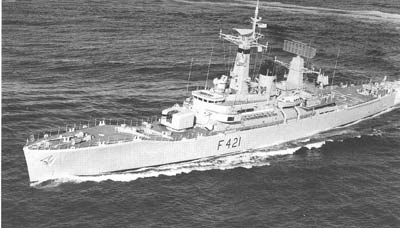 |  |
| HMNZS Canterbury | HMNZS Canterbury |
During the Falkland War (between United Kingdom and Argentina) which started in April 1982, HMNZS Canterbury relieved UK warships serving in the Persian Gulf so that these ships could serve off the Falkland Islands. She did this from June to August 1982. She was relieved by her sistership HMNZS Waikato and the Canterbury took over again in December 1982. She served till April 1983 when the Waikato took over again.
On 6 December 1984 when on exercises in the Bay of Plenty (North Island), a boiler pump failed and two days later the other failed as well. The Waikato had to tow the Canterbury back to Auckland. She was back at sea on 11 December 1984.
During the aftermath of the First Gulf War, the Canterbury patrolled the Persian Gulf during 1982-1983. In 1996 she assisted enforcing the embargo against Iraq. During the Australian-led INTERFET peacekeeping taskforce in East Timor, the Canterbury served there from 26 September to 12 December 1999.
The Canterbury also participated in a many humanitarian missions around the Pacific.
In the 1980s Australia and New Zealand decided to build new ships to replace their older warships. This project was called the Anzac Ship Project. By the early 2000s the Canterbury was showing her age (now 30+ years). In October 2003, a fire broke out in the auxiliary switchboard while the ship was off the Chatham Islands. The Canterbury was decommissioned on 21 March 2005.
The ship was sold to Northland Dive for $1 which set up the Bay of Islands Canterbury Charitable Trust. The ship was cleaned and all scrap metal and lead removed and sold (including the props). The gun turret was removed and is supposed to be installed at a Navy museum in Auckland. The people responsible for the scuttling said that they were disappointed in the cleanup work as far too much equipment was removed that did not need to be removed.
On 3 November 2007 the Canterbury was scuttled in Deep Water Cove at the Bay of Islands. On 15 July 2008 the wreck was on-sold to the local Maori tribe owned company Te Rawhiti Enterprises
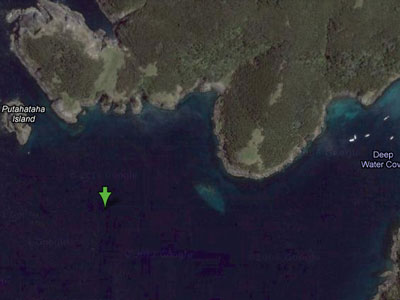 |  |
| The stern of the Canterbury is located at the arrow | This is the view to the north-east and the middle mooring |
The Canterbury now lies at a depth of about 36 metres on a sandy bottom in Deep Water Cove (tidal variation is over two metres in this area so depths can vary from what I have on this page). It is located at GPS S35° 11' 38.6" E174° 17' 42.2" (this is the stern mooring using WGS84 as a datum). It is easy to find as there are three moorings. The stern mooring is the eastern-most one and the bow mooring the western-most one. It is about 15 minutes from the Te Uenga Bay boat ramp in the Northland Dive boat, probably 20 minutes for most people.
As mentioned, the wreck faces west. While the wreck is basically level, the deepest part of the wreck is the stern as the prop shafts and rudders are on the sand. You could certainly do quite a few dives on this wreck as it is large (over 100 metres long) and there are many levels to explore. However, for overseas visitors who are only doing one or a couple of days diving in the Bay of Islands, I would recommend only one or two dives as there are lots of great reef dives that should be done.
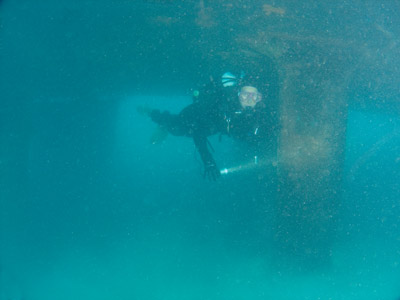 | 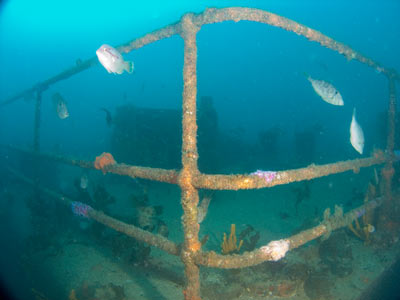 |
| Kelly and the rudder of the Canterbury | The port stern railing of the Canterbury |
The following descriptions are based on doing two dives on the wreck. For a first dive, use the stern mooring to start the dive. If you are on a charter boat, get them to drop you here and move to the middle mooring where you can ascend. The mooring is attached to the starboard side near the rear of the helicopter hangar. Once you reach the wreck you should be at about 28 metres. Drop right over the side and head towards the stern (if you want to see the prop shaft) or otherwise follow the deck to the stern.
The starboard prop shaft and rudder are more visible as the wreck has a slight list to port (why do virtually all natural and scuttle wrecks list or roll to the port?). The depth here is just over 36 metres. You only want to spend 30 seconds or so here as otherwise you will be greatly penalised with a reduced bottom time. When I dived the wreck it was a bit murky here as the tsunami from the disastrous Japanese earthquake of 11 March 2011 had stirred up the bays during the day. Ascend up to the stern and you will see that there is no entry from the stern hull area. This is unlike the Canterbury's sisterships HMNZS Waikato and HMAS Swan.
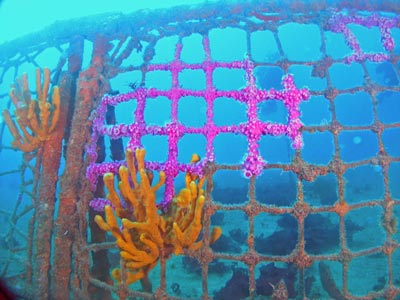 | 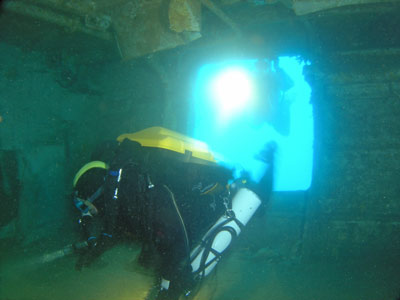 |
| The helipad railing/net of the Canterbury | Michael Wright enters the stern of the Canterbury |
If you want, have a look at the stern area. This is the helicopter landing pad and there are railings at the rear (above the stern) and on the port and starboard sides there are railings that drop down when the helicopter is landing. These railings are both upright and lying flat. There are great displays of jewel anemones on these railings.
If you head to the port side just forward of the stern you will see a hole giving access to the second level of the wreck. The entry is at about 34 to 35 metres. This is the main inside deck and is the deck you should explore on dive one. Inside, the wreck in this area is generally quite open and spacious. Even the passageways are quite large. Follow the passage and you will pass many cabins and rooms. On the right, the first one is the laundry. Unlike the Waikato and the Swan, the laundry here appears to be empty.
 |  |
| Kelly inside the middle of the wreck | The AA guns between the funnel and foremast |
Continue along the main passageway forward and there are many rooms to see. Off to the left are the dining areas and galleys. You can see through hatches in the floor the gearbox for the starboard engine. There are many holes leading to the outside from the rooms that run off the passageway. The depth remains about 33 metres all the way.
Soon you come to the middle section of the wreck. Here there are lots of wires hanging down, I am unclear why these would not have been removed during the ship cleaning work. You have to be careful not to get hooked up. By now Kelly and I were getting a bit low on bottom time so we headed out a hole to the starboard side and ascended to the main deck. We had spent almost six minutes inside the wreck and we were now 12 minutes into the dive. Normally you would continue on and exit at the gun turret.
If you exit the wreck here, ascend to the main deck and continue forward. The depth here is 30 metres. You can then come up along starboard hull and then onto the main deck in front of the bridge. Here you can see the location of the gun turret. The 4.5 inch gun turret and the guns has been removed, I am not sure where it was placed, but I assume some town now has it on display.
 | 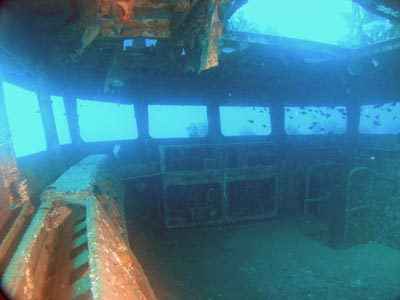 |
| Kelly outside the bridge of the Canterbury | Inside the bridge |
There is now a large circular hole where the turret once stood. This gives an excellent access point into and out of the bow section of the wreck. If you have not gone to the stern, then from here you could certainly swim to the bow itself. At the bow there are no anchors but you can see the anchor capstans and bollards. Back towards the turret there are two mini-bows. These look like bows and stick out of the deck. There purpose is to deflect any waves that come over the bow and direct the water over the sides of the ship rather than along the deck.
By now you will have been down about 18 minutes or so and will need to ascend a bit to stay out of decompression. You can head to the bridge area and enter under the bridge. There are a couple of ways inside, some doors either side of the superstructure. From here you can ascend into the bridge. Unfortunately, it has been totally stripped bare, not even a single gauge has been left. HMAS Swan had the Captain's chair left in place. There is, however, a toilet behind the bridge in a small room.
You can exit out the windows if you are careful or back the way you came in. From here you should swim to the funnel, then the rear mast. Take careful note of the funnel. It is constructed of aluminium but is corroding in a very strange way, with the aluminium (I think) turning to a sort of white paste. Very strange! It certainly will not last too much longer before collapsing.
 | 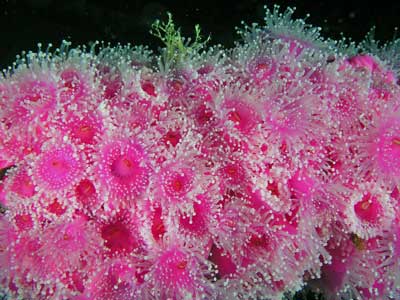 |
Kelly on the top of the remaining part
of the foremast of the Canterbury | A closeup of the jewel anemones |
Between the funnel and the foremast there are some anti-aircraft guns (four of them) and as you ascend, you will see lots of jewel anemones in places. The remains of the forward mast has a platform which was bent upwards on the port side when the ship sank. This is very colourful. The top of this part of the wreck is about 13 metres. On our dive, a bottom time (on the wreck) of 30 minutes meant we had to do a decompression stop of two minutes at three minutes. When we did a night dive here with a surface interval of almost three hours, we stayed above 28 metres and did 35 minutes without getting into decompression.
On subsequent dives here you can explore the wreck more. For a repetitive dive, I would stick to the main deck with only a short intrusion into deck 2. You can look in the helicopter hangar as well as the compartments under the bridge, foremast and nearby. If diving again as the first dive of the day, you could explore some more of the lower decks and enter the engine room.
 | 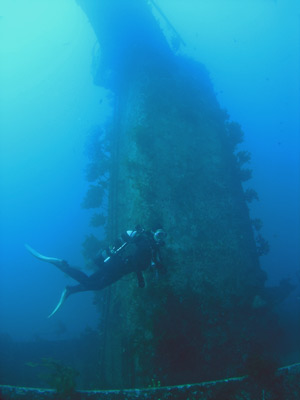 |
| Kelly passing the funnel | Kelly and the rear mast |
There is a lot of fish on this dive. You should see heaps of leatherjackets, kingfish, large and small snapper, moki (morwong) of various species and more. In compartments, especially off the main deck, there are crayfish, conger eels (especially at night) and some nice nudibranchs.
As it is in a bay and basically totally protected from the open ocean, it should be diveable in all but the worst weather conditions. You can dive the wreck from a private dive without incurring any fee.
This is a nice wreck dive, with lots to see and great fishlife as well. The night dive we did here was brilliant, with lots to see. Visibility when I dived the wreck was about 20 metres and in March, the water temperature over 21°C.
I dived with Northland Dive and I can certainly recommend Julia and Shane's service as being in the top couple of dive operations I have used anywhere in the world.
Return to the Bay of Islands menu.
References:
New Zealand Naval Vessels by R. J. McDougall - pages 45-48
| 
 v6.00.307 © 2003-2005
v6.00.307 © 2003-2005